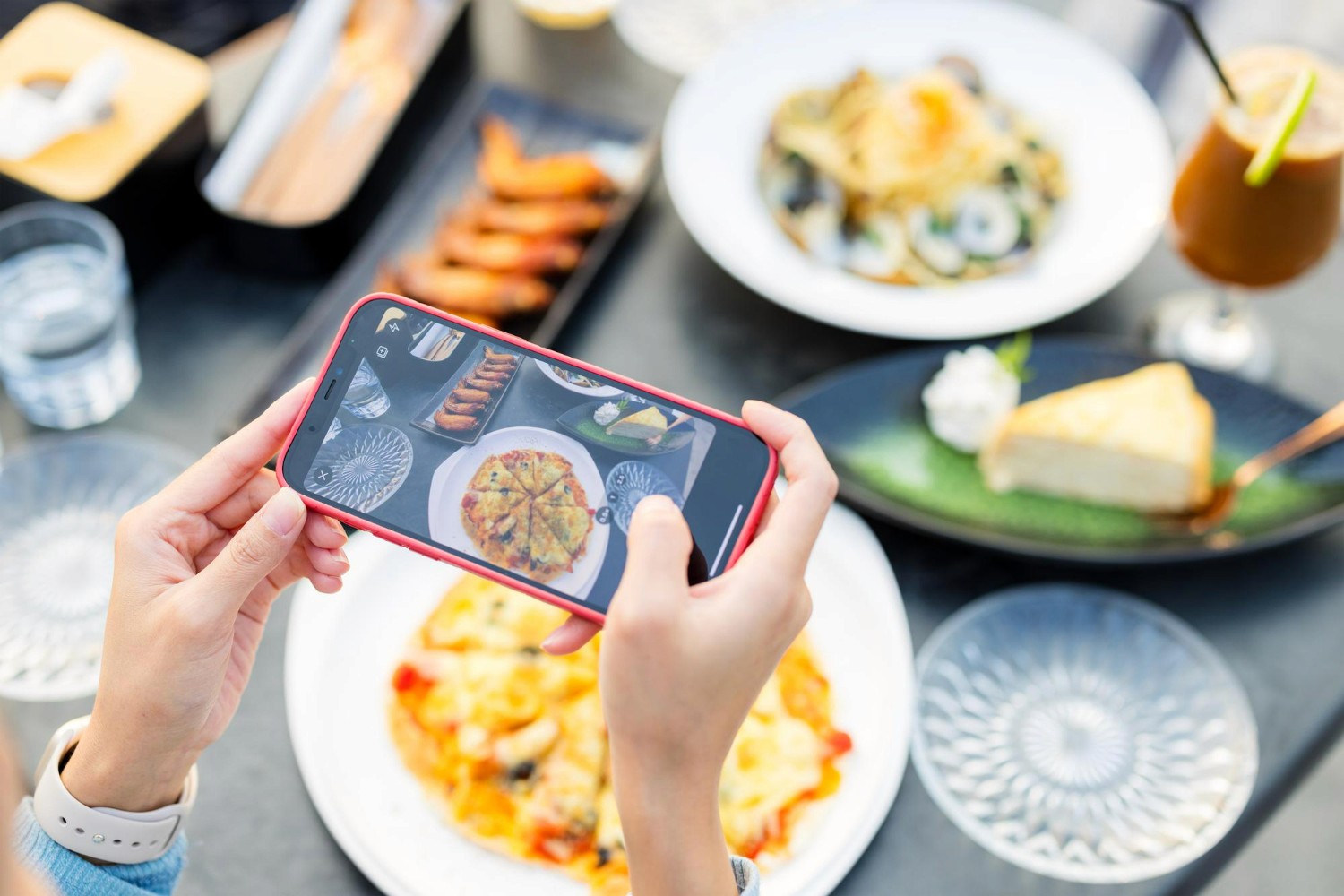Restaurant CRM software isn’t just a fancy phonebook listing your guests and their contact information. It’s a tool for building long-lasting relationships that go beyond great food and service.
Restaurants that use a customer relationship management (CRM) system have a unique opportunity to drive repeat business, loyalty, and profitability.
For every dollar invested, CRM software typically yields an average return on investment (ROI) of $8.71. When properly implemented, a CRM can boost ROI by up to 245% and skyrocket conversions by up to 300%!
The global CRM software market is set to reach $97.90 billion by 2025.
The restaurant CRM software market alone recorded $4.2 billion in 2024. It’s expected to more than double to $9.1 billion by 2033, at a compound annual growth rate (CAGR) of 9% between 2026 and 2033.
In this guide, we’ll explore what restaurant CRM software is, how to collect guest data, and how restaurants can effectively use CRM for retention, personalization, and growth.
What is a restaurant CRM system?
A CRM system in a restaurant is technology designed to help operators manage and analyze customer interactions and data throughout the customer lifecycle.
It’s a CRM designed specifically for the unique needs of restaurants and other F&B concepts like bars and nightlife, entertainment venues like golf clubs, and hotel restaurants, among others.
Like any CRM, it collects and stores customer information to improve retention, sales, and create personalization. However, a restaurant CRM focuses on guest-specific details like dietary restrictions, allergens, favorite dishes, seating preferences, order history, visit frequency, and even special occasions (birthdays or anniversaries).
Think of a restaurant CRM system as a central hub for all guest-related data, empowering concepts to build stronger guest relationships, grow, and boost profitability.
What are the benefits of using restaurant CRM software?
You’ll be able to gather data from various sources, which we’ll explore in the next section. But first, let’s look at the benefits of moving from pen-and-paper operations to a CRM system.
Move beyond basic data: Your CRM lets you move away from simple contact lists to rich, actionable customer intelligence. This includes gaining insights about your guests’ behavior, visiting frequency, buying patterns, and more.
Boost retention and loyalty: By understanding guest behavior, restaurants can implement loyalty programs and send personalized messages (via WhatsApp for restaurants, email, or SMS) with relevant offers.
Personalize guest experiences: From remembering a preferred table to suggesting dishes based on past orders, a restaurant CRM helps staff provide tailored service.
Streamline operations: Automation features can help with reservations management, restaurant marketing campaigns, and even feedback collection.
Gain actionable insights: CRM analytics allow restaurants to track customer behavior and other restaurant metrics, helping them make data-driven decisions to enhance the dining experience and drive repeat business.
Centralized guest profiles: Consolidating customer data from various touchpoints like POS, waitlist systems, reservation widgets, and Wi-Fi.
Communication modules: Modern restaurant CRM software, like Servme, come with marketing tools like email marketing, SMS, WhatsApp Business, and other features to engage with guests.
Analytics and reporting: Providing insights into customer behavior and campaign performance.
Further reading: The Ultimate Guide to SMS Marketing for Restaurants
The ultimate guest data checklist for restaurants
If you want your CRM to deliver real value, you need the right data.
This checklist outlines the most essential guest data points every restaurant should collect, along with where to capture them.
Basic contact information: This includes a guest’s name, email, and mobile phone, often collected via reservations, waitlists, or an opt-in.
Visit history: This includes visit dates, party sizes, table allocation, and occasions (if applicable). You can collect this from your POS, reservation system, or a combination of both.
Order behavior: This includes favorite or frequently-ordered dishes, average spend, dietary preferences (collected from an order or via the POS).
Feedback and sentiment: This covers collecting reviews via automated guest surveys and other restaurant review websites or platforms. You can capture this from your reservation and table management system.
Grab the full checklist with every piece of information to collect and where to get it from.
How and where to capture guest data for your restaurant CRM software
Effective data capture is the foundation of a powerful restaurant CRM.
Here's how to gather valuable guest information from various touchpoints:
Reservation management systems: Platforms like Servme and OpenTable are crucial for initial data capture. They collect contact details, pre-service notes, and guest preferences, which are then automatically added to guest profiles in the CRM.
POS platforms: By integrating your F&B POS system into your CRM, you can collect data and automatically track guest orders and visit patterns. This provides insights into dining preferences, average spend, and frequency, essential for targeted marketing and menu development.
Feedback tools: Ask for guest feedback through digital surveys and online reviews. This provides real-time sentiment analysis and highlights areas for improvement, directly from your customers' experiences.
Walk-in data capture: Don't overlook walk-ins. Use waitlist management software, like Servme, or restaurant loyalty programs to capture basic contact information. This helps you build and populate guest profiles, not just those with reservations.
How often should guest data be updated?
One of the frequently asked questions about restaurant CRM is related to updating information. Having a CRM system that’s not updated is almost the same as not having one.
That’s why we highly recommend regularly updating guest data in your CRM. Ideally, you should update data in real-time, via reservations, waitlists, POS, and feedback tools. That way, your CRM reflects the latest guest behavior and preferences.
Restaurant CRM software: Your key to personalization and growth
Now, let’s see how you can use your CRM system to enhance operations, identify customer patterns, and ultimately boost your profits.
Learn more about your guests
More than a simple contact list, your CRM system helps you gain insights into customer behavior, identify patterns, and discover new opportunities for engagement and growth.
The richer data you capture, the more opportunities you can create with your CRM.
With guest data, you can identify your top spenders, frequent visitors, among others. You can create your own tags with attributes.
For example, you can create a VIP tag for guests who visit at least once a month and spend over AED 500 or $100 per visit.
Create a separate tag for guests who visit your venue on Valentine’s Day or try your Halloween menu. Use this data for future marketing campaigns.
Identify slow and peak seasons
Use your restaurant CRM system to identify your restaurant’s peak seasons, including peak hours, days, weeks, and months. You can also use it to identify slow times or days in a restaurant.
In the UAE, peak season begins in October till March and may extend to May. On the other hand, the slowest day is usually Monday both in the UAE and US.
However, the case might be different for your restaurant or bar, especially if you’re located in a different country with different customer behavior.
Using the data, you can create prix-fixe menus for weekdays or certain times of the day to increase restaurant foot traffic on weekday bookings.
Forecast demand to optimize inventory
Use historical data to forecast demand, improve inventory management, and enhance menu optimization. Using demand data can also improve your menu engineering efforts.
Further reading: 7 Best Inventory Software for Restaurants
Personalize the in-house experience
One of the top benefits of a restaurant CRM is creating personalized dining experiences.
This includes addressing guests by their names, offering tailored menu recommendations, and suggesting coffee or dessert based on previous behavior. Remembering seating preferences is also a benefit.
Your CRM can be an opportunity to empower staff to make the dining experience more memorable and enjoyable for guests.
Explore several examples of what personalization looks like in a restaurant.
Automate personalized marketing campaigns
Besides personalizing the in-house experience, you can add personalization to your marketing efforts.
If you’re using Servme, you can build your entire personalized messaging strategy, including email, SMS, and WhatsApp, in Servme.
Create and automate marketing campaigns for first-time guests, loyal guests, and churned or other customers.
For email, you can create a restaurant newsletter to increase online reservations, unveil new dishes and menus, and more.
Take personalization further and send guests an email, SMS, or WhatsApp message for their birthday or anniversary. We recommend adding a special birthday or anniversary offer to entice the guest to your restaurant or bar.
Further reading: 10+ Restaurant Email Marketing Campaign Ideas for Better Sales & Retention
Segmentation and guest retargeting
Enhance guest segmentation and identify lapsed or lost customers. These are guests who have not visited your venue, or any of your venues, in the last 3, 6, or any-number-of months.
Use your restaurant CRM software to identify those guests and create retargeting campaigns to win them back.
You can also send guest surveys to learn more about why those guests have stopped visiting you.
Choose the right restaurant CRM solution
To select the best restaurant CRM software, focus on these key areas:
Comprehensive functionality: Prioritize a system that offers various features beyond basic CRM, such as detailed guest profiling and segmentation features. One such feature in Servme, for example, is the auto-tagging feature. Your restaurant CRM should be part of a bigger restaurant software solution like seating and reservation management, guest analytics, and marketing automation. This ensures a holistic approach to managing your restaurant's operations and guest relationships.
Easy to integrate with other software: Consider a CRM that seamlessly connects with your existing restaurant point-of-sale (POS) system, online ordering platforms, property management systems (PMS) for hotels, phone systems, and payment gateways. It should also integrate with your booking channels like Tripadvisor and Zomato. This creates a unified data view and avoids data silos. Servme offers strong integrations, including Oracle PMS, various POS integrations, allowing you to combine data from various sources to create better guest profiles.
Ease-of-use and support: The CRM you choose needs to be intuitive for all staff, from managers to servers, to ensure high adoption rates. Look for strong reporting capabilities, mobile and multi-device access, and reliable vendor support. Customers praise Servme’s restaurant CRM for its dedicated customer support and user-friendliness, which are vital for smooth operation.
Goal and budget alignment: Price is always a factor when making a decision. Choose a system whose features and cost align with your restaurant's size and objectives. Consider the long-term value and expansion plans. For example, if you want to manage multiple restaurant locations, you need a CRM that supports your expansion. Servme also helps F&B and restaurant groups manage multiple brands and venues with CRM, reservations, and marketing.
Data reporting: A critical feature in restaurant CRM software today is data. Make sure your choice includes powerful reporting and analytics features as this will help you track your marketing and personalization campaigns.
Staff empowerment: Ensure the CRM provider offers comprehensive onboarding to help your team understand its value and use. Staff can use CRM's insights to personalize guest interactions, anticipate needs, and enhance the overall dining experience, ultimately increasing customer loyalty in your restaurant.
Regular updates: Choose a restaurant CRM with regular updates and new features. Make sure it’s a solution where the team listens to your needs as a customer. At Servme, we’ve implemented various features based on customer requests, including Manager’s Notes, along with updates such as Guestbook V2.
The future of CRM software for restaurants
To recap, restaurant CRM software is no longer a luxury for dining concepts. It’s a must-have tool for restaurants that want to streamline operations, grow, and stay profitable in a competitive F&B market.
A well-utilized restaurant CRM system like Servme provides a competitive edge, transforming first-time diners into loyal advocates through personalized experiences and targeted communication.
Investing in CRM is investing in sustainable growth, deeper guest connections, and a more profitable future for your restaurant.
Discover how Servme’s CRM can transform your restaurant and grow your business.
Nada Sobhi
Guest CRM



